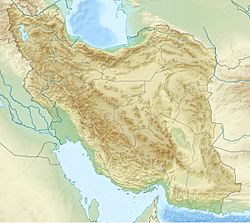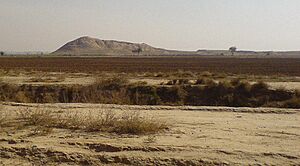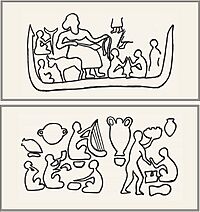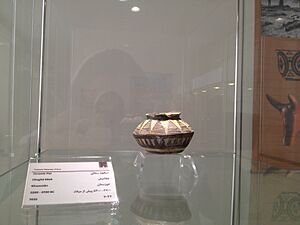Chogha Mish facts for kids
| [[File::None at this time|frameless]] | |
| Location | Khuzestan province, Iran |
|---|---|
| Coordinates | 32°12′33″N 48°32′46″E / 32.20917°N 48.54611°E |
| Type | Settlement |
| Site notes | |
| Excavation dates | 1961-1978 |
| Archaeologists | Pinhas Delougaz, Helene J. Kantor |
| Condition | In ruins |
Chogha Mish (pronounced Cho-gah Meesh) is an incredibly old settlement in Iran. It dates back to about 6800 BC, which is almost 9,000 years ago! This ancient place is found in the Khuzistan Province, on a flat area called the eastern Susiana Plain.
People lived here for a very long time, starting in the Neolithic period (when farming began) and continuing through the Chalcolithic period (when people started using copper tools). They even stayed until the Uruk period, which is when early forms of writing first appeared. This means Chogha Mish was important for thousands of years.
Around 4400 BC, Chogha Mish became less important. Another nearby city called Susa then became the main cultural center. Chogha Mish is located near the Dez River, about 25 kilometers (15 miles) east of ancient Susa.
Contents
Exploring Chogha Mish: What We Found
The site of Chogha Mish looks like a cone-shaped hill with a large flat area next to it. The hill is about 200 by 150 meters wide and stands about 27 meters (almost 90 feet) tall. The flat area, called a terrace, is even bigger, about 400 by 300 meters.
Archaeologists, who are like history detectives, dug at Chogha Mish from 1961 to 1978. Teams from the University of Chicago Oriental Institute and the University of California at Los Angeles led these digs. They found many amazing things!
Ancient Buildings and Tools
At the top layers of the mound, they found structures from the early 2nd millennium BC. These included a fort built by the Elamite people. Below these, they uncovered many remains from the Protoliterate period, which is when writing was just starting.
Some interesting finds included small, round stone disks. These were about 4 to 5 centimeters (about 2 inches) wide. Experts think they were used as counters, maybe for keeping track of goods.
They also found many clay cylinder seals from the 4th millennium BC. These seals were rolled onto wet clay to leave an impression. The pictures on them show people spinning thread, weaving cloth, and even churning butter!
A huge number of broken pieces of pottery were found, about a quarter million! Many of these were "beveled rim bowls," which are a special type of pottery. These bowls are a key sign of the Uruk period culture.
One very special discovery was a beautiful Elamite cup. It was made from a soft, dark stone. The handle of the cup was carved to look like a goat!
Pottery Making at Chogha Mish
Archaeologists found pottery kilns (ovens for baking clay) at Chogha Mish. These kilns date back to different periods, from the Middle Susiana period to the Uruk period.
One kiln found at Chogha Mish is very important. It's a double-chamber kiln, meaning it had two parts, and it's the earliest known example of its kind. This type of kiln was later used in other ancient cities in Mesopotamia. It shows how advanced the people of Chogha Mish were in making pottery.
Early Steps Towards Writing
Before people wrote on tablets, they used small clay shapes called "tokens." These tokens were like early ways to count or keep records. Sometimes, these tokens were put inside hollow clay balls, like envelopes, called "bullae."
About 135 of these tokens were found at Chogha Mish. They came in different shapes, like cones, spheres, and discs. These tokens were used across the ancient Middle East around 3500-3200 BC. Archaeologists also found at least 28 clay envelopes with seal impressions on them.
These tokens and envelopes were usually thrown away after they were used. The ones found at Chogha Mish are from the same time as important discoveries in Uruk and Susa. One "numerical tablet" (a tablet with numbers) was also found.
Sadly, the building where many of the finds and records were stored was destroyed during the Iranian Revolution. Because of this, some important information was lost.
The Story of Chogha Mish
Chogha Mish started as a small settlement around the middle of the 6th millennium BC. It grew to its largest size, covering about 17 hectares (about 42 acres), in the Late Susiana period, around the beginning of the 5th millennium BC.
During the early 5th millennium BC, a major building at Chogha Mish was destroyed. This event is known as the 'Burnt Building' destruction. After this, some other settlements in the area were also abandoned. People then started moving more to the west, and the city of Susa began to grow and become powerful.
Chogha Mish is very important because it shows how early people in the Susiana region were connected to Mesopotamia (modern-day Iraq). The discoveries here prove that the Early Susiana period happened at the same time as other important periods in Mesopotamia, like the Ubaid 1 period.
Archaeologists have said that Chogha Mish was the largest population center in its region before the 5th millennium BC. The digs showed that the society and economy there became more complex over time. Then, it was temporarily abandoned around 4800 BC.
Images for kids
See also
- Cities of the ancient Near East
- Proto-cuneiform
- Proto-Elamite
- Tall-i Bakun










